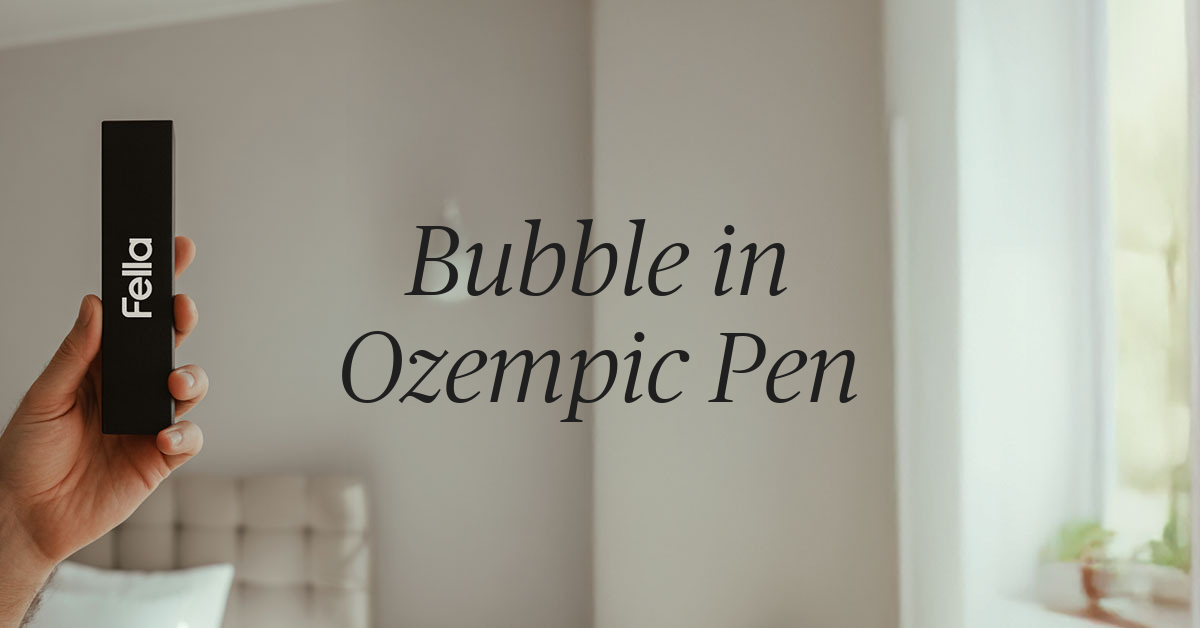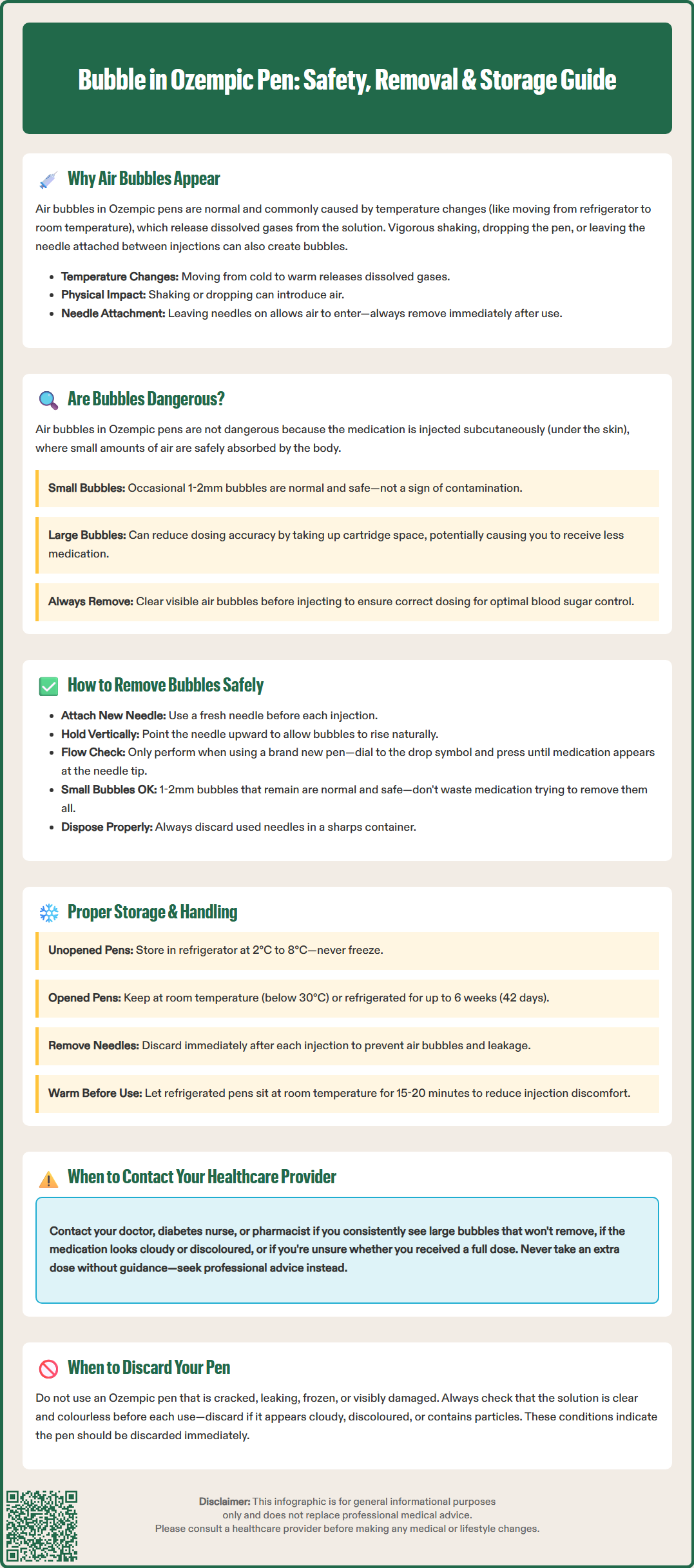
Air bubbles in Ozempic pens are a common concern for patients using this injectable semaglutide medication for type 2 diabetes management. Whilst the appearance of bubbles can be alarming, they typically result from normal temperature changes, handling, or dissolved gases in the solution. Understanding why bubbles form, whether they pose any risk, and how to remove them safely is essential for confident self-administration. This article provides evidence-based guidance on managing air bubbles in Ozempic pens, proper storage techniques, and when to seek professional advice, helping patients maintain accurate dosing and optimal glycaemic control.
Quick Answer: Air bubbles in Ozempic pens are common, not dangerous for subcutaneous injection, and can be safely removed using proper technique to ensure accurate dosing.
Air bubbles in Ozempic (semaglutide) pens are a common occurrence and typically result from normal handling and storage conditions. Understanding why these bubbles form can help patients manage their injectable medication with confidence.
Temperature fluctuations represent a frequent cause of bubble formation. When the pen moves between different temperatures—such as from refrigerator storage to room temperature—dissolved gases in the solution may be released, forming visible bubbles. This is a normal physical response and does not indicate a fault with the medication itself.
Handling factors can contribute to bubble formation. Vigorous shaking or dropping the pen may cause dissolved gases within the solution to form visible bubbles. Importantly, leaving a needle attached to the pen between injections can allow air to enter the system and cause medication leakage—always remove the needle immediately after each injection.
Manufacturing and filling processes, whilst highly controlled, involve working with liquid solutions that may contain minute quantities of dissolved gases. These may become visible as small bubbles under certain conditions.
It is important to note that the presence of small air bubbles does not compromise the sterility of Ozempic or indicate contamination. The medication remains safe and effective when small bubbles are present, provided the pen has been stored correctly and has not exceeded its expiry date. Do not use a pen that is cracked, leaking, has been frozen, or appears damaged. Patients should not be alarmed by occasional small bubbles but should follow the manufacturer's instructions for proper pen use.

Mounjaro® is the most innovative GLP-1 medication proven to dramatically curb appetite, hunger, and cravings to help professional men achieve substantial weight loss.
Start Here
Wegovy® is a weekly injectable GLP-1 medication with proven effectiveness in reducing appetite, hunger, and cravings to help busy professionals lose significant weight.
Start HereThe presence of air bubbles in your Ozempic pen is not dangerous and does not pose a direct health risk. This reassurance is important, as many patients understandably feel concerned when they notice bubbles in their injectable medication.
Subcutaneous injection safety: Ozempic is administered subcutaneously (under the skin into fatty tissue), not intravenously. Small amounts of air injected into subcutaneous tissue are harmlessly absorbed by the body without causing harm. This differs significantly from intravenous injections, where air bubbles could theoretically pose risks. The subcutaneous route provides an inherent safety margin that makes small air bubbles clinically insignificant.
Dosing accuracy concerns: Whilst air bubbles are not dangerous, they can affect the accuracy of your dose. If a large bubble occupies space in the cartridge, you may receive slightly less medication than intended. For Ozempic, which is dosed weekly at specific strengths (0.25 mg, 0.5 mg, 1 mg, or 2 mg), ensuring precise dosing is important for optimal glycaemic control in type 2 diabetes management.
When to seek advice: You should contact your GP, practice nurse, or diabetes specialist if you consistently notice large bubbles that cannot be removed, if the medication appears cloudy or discoloured, or if you have concerns about whether you received your full dose. If you think you received less than a full dose, do not take an extra dose—seek advice from your prescriber, diabetes specialist nurse or pharmacist. Additionally, if you experience unexpected changes in blood glucose control or side effects, discuss these with your healthcare team.
If you experience any side effects or device problems with your Ozempic pen, you can report these through the MHRA Yellow Card scheme (yellowcard.mhra.gov.uk or via the Yellow Card app).

Removing air bubbles from your Ozempic pen is a straightforward process that helps ensure accurate dosing and builds confidence in self-administration.
Step-by-step bubble removal technique:
Attach a new needle: Always use a fresh needle for each injection. Remove the outer and inner needle caps, ensuring the needle is securely attached to the pen.
Perform a flow check (for new pens only): Before using a new pen for the first time, you must check the flow. Hold the pen with the needle pointing upward. Turn the dose selector to the flow check symbol (a small drop icon). Press and hold the dose button until you see a drop of medication appear at the needle tip. This confirms proper flow and helps remove air from the needle.
If no drop appears: If no drop appears after several attempts, change the needle and try again. If still unsuccessful, contact Novo Nordisk and use a new pen.
For subsequent injections: The flow check is only needed before the first use of each new pen, not before every injection. For regular injections, simply dial your prescribed dose after attaching a new needle.
Hold the pen upright: When preparing your injection, position the pen vertically with the needle pointing upward. This allows any air bubbles to rise toward the needle end.
Important considerations: Small bubbles (1-2 mm) that remain visible are acceptable and will not affect your dose significantly. Do not repeatedly attempt to remove all bubbles by performing additional flow checks, as this may waste medication.
Always dispose of used needles in a proper sharps container. If you are uncertain about the technique, ask your practice nurse or diabetes specialist nurse to demonstrate the process. Many NHS diabetes services offer injection technique reviews as part of routine care.
Correct storage and handling of your Ozempic pen minimises bubble formation, maintains medication efficacy, and ensures patient safety throughout the treatment period.
Storage requirements:
Unopened pens: Store in a refrigerator between 2°C and 8°C. Keep the pen in its original carton to protect from light. Do not freeze; if accidentally frozen, discard the pen as freezing can damage the medication's molecular structure.
In-use pens: Once you begin using a pen, it may be stored at room temperature (below 30°C) or continued in the refrigerator for up to 6 weeks (42 days). Many patients find room temperature storage more comfortable for injections, as cold medication can cause mild discomfort at the injection site.
Travel considerations: When travelling, Ozempic pens can remain at room temperature for the duration of the 6-week in-use period. Use an insulated medication travel case if exposed to temperatures above 30°C, but avoid direct contact with ice packs, which could cause freezing. Consider carrying a spare pen and needles for longer trips.
Handling best practices:
Allow refrigerated pens to reach room temperature (15-20 minutes) before injection to improve comfort.
Always remove and safely discard the needle immediately after each injection. Leaving needles attached can introduce air and cause medication leakage.
Store pens with the cap on to protect from light, away from direct sunlight and heat sources.
Inspect the medication before each use. Ozempic should be clear and colourless. Do not use if the solution appears cloudy, discoloured, or contains particles.
Keep pens out of reach of children and never share pens between patients, even if the needle is changed.
The NHS provides additional resources through diabetes specialist teams, and the patient information leaflet included with Ozempic contains comprehensive storage guidance. If you have specific questions about storage during unusual circumstances, consult your community pharmacist for tailored advice.
No, air bubbles in Ozempic pens are not dangerous. Because Ozempic is injected subcutaneously (under the skin), small amounts of air are harmlessly absorbed by the body without causing harm, unlike intravenous injections where air could pose risks.
A flow check to remove air is only required before the first use of each new pen. For subsequent injections, simply attach a new needle and dial your prescribed dose; small bubbles (1–2 mm) that remain are acceptable and will not significantly affect dosing.
Store unopened pens in a refrigerator at 2–8°C and never freeze them. Once in use, pens may be kept at room temperature below 30°C for up to 6 weeks. Always remove the needle immediately after injection and store the pen with its cap on, away from direct light and heat.
All medical content on this blog is created based on reputable, evidence-based sources and reviewed regularly for accuracy and relevance. While we strive to keep content up to date with the latest research and clinical guidelines, it is intended for general informational purposes only.
DisclaimerThis content is not a substitute for professional medical advice, diagnosis, or treatment. Always consult a qualified healthcare professional with any medical questions or concerns. Use of the information is at your own risk, and we are not responsible for any consequences resulting from its use.